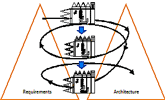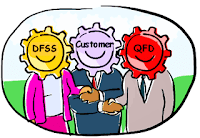The 2-day symposium welcomes people of all levels QFD, from the beginner to the experienced, people of countries and industries. It is complimentary to the attendees of QFD Green Belt® Certificate Course and QFD Black Belt® Certificate Course We hope you will join us!
See the previous posts:
QFD and Requirements Prioritization: A Survey on Security Requirements for Cloud Computing
 Prioritization is an essential task within QFD, and QFD is highly suitable for the development of Cloud Computing (CC) applications where non-functional requirements play a main role. Many of them are security requirements, often the main concern for CC investments. This paper introduces the usage of QFD for Cloud Computing (CC). In this research, CC security requirements were prioritized by pairwise comparison, showing that not all security requirements are equally important. With this finding, the appropriate usage of QFD for CC development will be discussed.
Prioritization is an essential task within QFD, and QFD is highly suitable for the development of Cloud Computing (CC) applications where non-functional requirements play a main role. Many of them are security requirements, often the main concern for CC investments. This paper introduces the usage of QFD for Cloud Computing (CC). In this research, CC security requirements were prioritized by pairwise comparison, showing that not all security requirements are equally important. With this finding, the appropriate usage of QFD for CC development will be discussed.Keywords: QQFD, Requirements Prioritization, Security Requirements, Cloud Computing, GERMANY
. . . . . . . . . . . . . . . . . . . . . . . . . . . . . . . . . . .
Improving a Learning Management System based on QFD and Service Oriented Architecture (SOA)
 This paper reports how to improve web-based Learning Management Systems (LMS) through integration of the elements of Service Oriented Architecture (SOA) and Quality Function Deployment (QFD).
This paper reports how to improve web-based Learning Management Systems (LMS) through integration of the elements of Service Oriented Architecture (SOA) and Quality Function Deployment (QFD). The users of an LMS are typically invisible to the systems developers and administrators, However, understanding the user needs has high priority in any networked learning systems, in order to develop and implement effective virtual learning services that meet diverse expectations of the users. An example will be presented based on a Turkish platformed LMS.
Keywords: Learning Management System, Service, Service Oriented Architecture (SOA), QFD (Quality Function Deployment), TURKEY
. . . . . . . . . . . . . . . . . . . . . . . . . . . . . . . . . . .
A Study of Service Quality Improvement Using the Theories of Nonverbal Communication, FMEA and QFD
 Study of service industry presents unique challenges because of soft issue measurements such as quality evaluation and service quality.
Study of service industry presents unique challenges because of soft issue measurements such as quality evaluation and service quality. With this in mind, the authors propose a quality improvement process specifically for service industry. The presentation will include a case study using non-verbal communication, FMEA, and QFD.
Keywords: Service Quality Improvement, QC story, QFD, JAPAN
. . . . . . . . . . . . . . . . . . . . . . . . . . . . . . . . . . .
A Statistical Engineering Approach to Codifying the Voice of the Customer
 Virtually all design projects involve the collection/processing of the Voice of the Customer to develop a set of requirements to which the producer designs their process/product.Approaches to efficiently and effectively deriving those requirements involve multiple techniques from the fields of market research, quality engineering, design engineering, and inferential statistics. This paper proposes a way to create a logical flow for the Voice of the Customer processing by codifying a series of tools into a linear statistical engineering road-map, and thereby more efficiently populating the House of Quality matrix that uses the "whats" (functions) and "hows" (functional requirements) approach. The exposition is supplemented with a lucid hypothetical example.
Virtually all design projects involve the collection/processing of the Voice of the Customer to develop a set of requirements to which the producer designs their process/product.Approaches to efficiently and effectively deriving those requirements involve multiple techniques from the fields of market research, quality engineering, design engineering, and inferential statistics. This paper proposes a way to create a logical flow for the Voice of the Customer processing by codifying a series of tools into a linear statistical engineering road-map, and thereby more efficiently populating the House of Quality matrix that uses the "whats" (functions) and "hows" (functional requirements) approach. The exposition is supplemented with a lucid hypothetical example. Keywords: Voice of Customer, Function Analysis, Kano classification, Analytic Hierarchy Process, Function Requirements, Specifications, Quality Function Deployment, USA
View more papers & presentations
QFD Courses at this symposium
How to Attend














